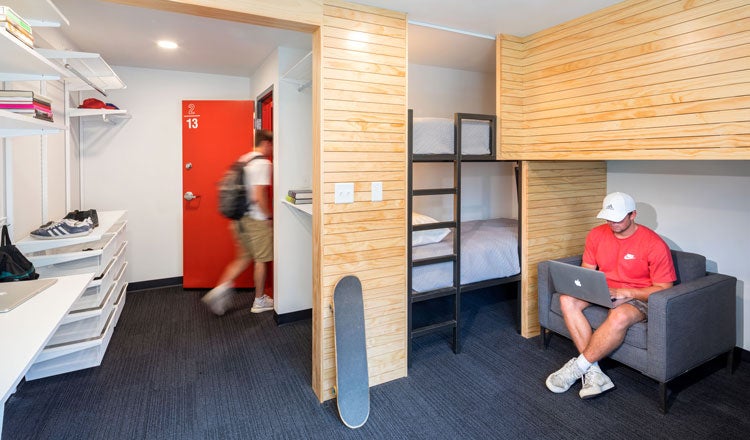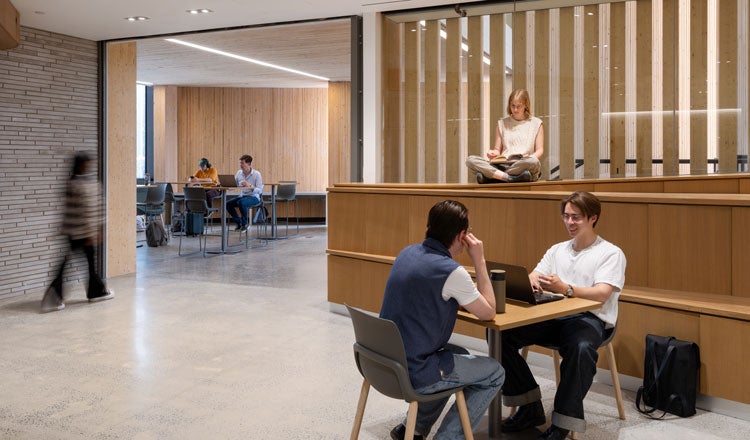
Designing Canadian Student Housing for Flexibility, Belonging and Long-Run Value
When I first wrote about affordability, amenities and sustainability in student housing in 2022, it was in the context of a post-pandemic return to campus. At the time, we saw waitlists grow, off-campus rents rise and sustainability emerged as a clear differentiator for students choosing where to live and study.
The principles I outlined then still essentially hold, though the current geopolitical environment has shifted governmental focus and altered immigration and enrolment policies. Affordability for students and institutions is about more than the cost to rent a room; it is also about whether, societally, we can afford to develop affordable housing in light of flattening enrollments and changes to the academic landscape.
State of Student Housing
Canada's higher education landscape has undergone significant shifts in ways few of us could have predicted. Since early 2024, the federal government has imposed a two-year cap on new international study permits, with the allocation again reduced in 2025 to approximately 437,000 permits nationwide (Immigration, Refugees and Citizenship Canada, 2025). While designed to address pressure on the broader housing and employment markets, the cap has introduced new volatility into student intake planning, requiring institutions to be nimble without compromising long-term value.
Meanwhile, the off-campus housing market remains tight. The Canada Mortgage and Housing Corporation reported that the national purpose-built rental vacancy rate rose to 2.2% in 2024 from 1.5% in 2023, but it's still well below the ten-year average. Two-bedroom rents climbed another 5.4% in 2024, following a record 8% increase the year before (Canada Mortgage and Housing Corporation, 2025). For most students, this means that off-campus options remain scarce and expensive, reinforcing the appeal and necessity of well-designed on-campus options.
Four Characteristics of Well-Designed Student Housing
So, what does "well-designed" student housing mean in 2025, from a Canadian context? From my perspective, four characteristics stand out, each rooted in the same principles I shared in 2022 but sharpened for today's realities.
1. Flexible Student Housing for Changing Enrolment Patterns
Student housing demand can swing with policy shifts, economic changes and global mobility patterns. Flexibility in how spaces are planned and utilized can help institutions adapt to these changes without compromising the student experience.
At North Island College's Comox campus, scheduled to open in 2025, housing options are divided among microunits, studios, quads and family-style accommodations. Providing a range of options and pricing offers a buffer for changes in enrolment due to economic conditions, such as a surge in trades training. Providing apartment-style units for families enables adult students to return to school for shorter periods without having to leave their families behind. Conversely, students who support elder family members can also return to school and have housing available.
2. Student Amenities Built Around Campus Context
There's no one-size-fits-all formula for housing amenities. The right mix depends on the institution's existing facilities, the needs of its student body and the character of its campus location.
Capilano University's housing project is designed to include focused student spaces to support their new 24/7 campus life. Without existing student housing, dining facilities and study spaces in academic buildings were not available. Double-occupancy dorm-style bedrooms keep this predominantly first-year student building affordable, with shared private washrooms located on each floor. By providing kitchens on each level along with lounges and quiet study areas, each floor became its own community within the building. By incorporating diverse spaces, housing is largely self-contained, meeting most student needs and enabling the campus to close overnight, on weekends, and during the summer while continuing to support those in residence.

3. Sustainability as a Cost Strategy for Student Housing
Sustainability in student housing isn't only about environmental responsibility and long-term cost control. Design choices made at the start of a project can have lasting impacts on operations, maintenance and student experience.
All the student housing projects I've been involved with have had impressive sustainability mandates. These are primarily driven by the Ministry based on funding criteria (LEED Gold+, BC Energy Step Code 4+) and are in coordination with the Federal Government's decarbonization mandates. More recently, some of these requirements have been reduced to align with financial targets. Different institutions need to determine the best way to align their campus guidelines with project budgets. Is mass timber the right avenue for carbon reduction? Are advanced energy strategies for operational cost reductions and campus carbon balancing the best approach? If a campus is located in the north, where peak loads occur during cold months, is a 100% electric heating facility a feasible option? These are all questions worth asking.
4. Housing Accommodations for the Nontraditional Student
Recent secondary school graduates are not the only people who live and learn on campus. A growing share of students are older, returning, part-time or balancing work and family responsibilities. In fall 2023, 421,000 part-time students — nearly a third of all university students — were enrolled in Canada (Universities Canada, 2023). Housing can be designed to support these learners while still meeting the needs of traditional residents.
For two recent business cases, the primary student body requiring support was not full-time students or those who would enroll in the institution for a full four- or five-year term. With shorter-term stays becoming a growing norm (eight-week programs, for example), the facility must support a quick operational turnover without significant vacancy gaps. It's recommended that an operational model and scenarios be run concurrently with building programming to determine the optimal unit mix and identify the types of spaces (such as laundry, storage and housekeeping) required to operate effectively in this nontraditional model. Additionally, if students bring a partner, are there areas on campus or within the building that accommodate remote work?

Designing for modern higher education is a balancing act. Institutions must reinforce affordability for students, ensure financial practicality and build resilience against external shocks while delivering healthy, community-oriented spaces that support academic success and remain viable over time. As the student housing landscape continues to evolve, it’s clear that relevance, sustainability and well-being are essential pillars of a complete student experience.




